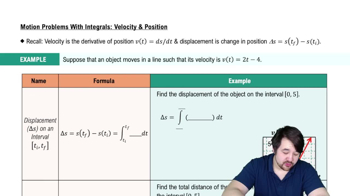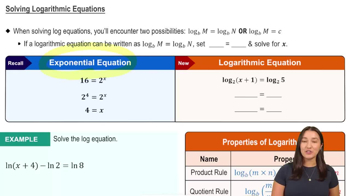Quadratics having a common tangent line The curves y = x² + ax + b and y = cx − x² have a common tangent line at the point (1,0). Find a, b, and c.
Table of contents
- 0. Functions7h 54m
- Introduction to Functions16m
- Piecewise Functions10m
- Properties of Functions9m
- Common Functions1h 8m
- Transformations5m
- Combining Functions27m
- Exponent rules32m
- Exponential Functions28m
- Logarithmic Functions24m
- Properties of Logarithms36m
- Exponential & Logarithmic Equations35m
- Introduction to Trigonometric Functions38m
- Graphs of Trigonometric Functions44m
- Trigonometric Identities47m
- Inverse Trigonometric Functions48m
- 1. Limits and Continuity2h 2m
- 2. Intro to Derivatives1h 33m
- 3. Techniques of Differentiation3h 18m
- 4. Applications of Derivatives2h 38m
- 5. Graphical Applications of Derivatives6h 2m
- 6. Derivatives of Inverse, Exponential, & Logarithmic Functions2h 37m
- 7. Antiderivatives & Indefinite Integrals1h 26m
- 8. Definite Integrals4h 44m
- 9. Graphical Applications of Integrals2h 27m
- 10. Physics Applications of Integrals 3h 16m
- 11. Integrals of Inverse, Exponential, & Logarithmic Functions2h 31m
- 12. Techniques of Integration7h 41m
- 13. Intro to Differential Equations2h 55m
- 14. Sequences & Series5h 36m
- 15. Power Series2h 19m
- 16. Parametric Equations & Polar Coordinates7h 58m
3. Techniques of Differentiation
Basic Rules of Differentiation
Problem 29
Textbook Question
Airplane takeoff Suppose that the distance an aircraft travels along a runway before takeoff is given by D = (10/9)t², where D is measured in meters from the starting point and t is measured in seconds from the time the brakes are released. The aircraft will become airborne when its speed reaches 200 km/h. How long will it take to become airborne, and what distance will it travel in that time?
 Verified step by step guidance
Verified step by step guidance1
First, convert the speed from km/h to m/s. Since 1 km/h is equal to 1/3.6 m/s, convert 200 km/h to m/s by multiplying 200 by 1/3.6.
Next, find the expression for speed as a function of time by differentiating the distance function D = (10/9)t² with respect to time t. This gives the velocity function v(t) = dD/dt.
Set the velocity function equal to the converted speed in m/s to find the time t when the aircraft becomes airborne. Solve the equation v(t) = converted speed for t.
Substitute the value of t found in the previous step back into the original distance function D = (10/9)t² to find the distance traveled by the aircraft at the time it becomes airborne.
Verify the units and calculations to ensure that the time and distance are consistent with the problem's requirements, ensuring the solution is physically meaningful.
 Verified video answer for a similar problem:
Verified video answer for a similar problem:This video solution was recommended by our tutors as helpful for the problem above
Video duration:
3mPlay a video:
Was this helpful?
Key Concepts
Here are the essential concepts you must grasp in order to answer the question correctly.
Kinematics and Speed
Kinematics involves the study of motion without considering its causes. Speed is a key aspect, defined as the rate of change of distance with respect to time. In this problem, the aircraft's speed must reach 200 km/h for takeoff, requiring conversion to meters per second (55.56 m/s) to match the units used in the equation for distance.
Recommended video:

Using The Velocity Function
Differentiation
Differentiation is a fundamental concept in calculus used to find the rate at which a quantity changes. To determine the aircraft's speed, differentiate the distance function D = (10/9)t² with respect to time t. This yields the velocity function, v(t) = (20/9)t, which can be used to find the time when the speed reaches 55.56 m/s.
Recommended video:

Finding Differentials
Solving Quadratic Equations
Solving quadratic equations is essential for finding specific values of variables that satisfy given conditions. Once the velocity function is set equal to the required speed, solve the resulting equation (20/9)t = 55.56 for t. This will provide the time needed for the aircraft to reach the necessary speed for takeoff.
Recommended video:

Solving Logarithmic Equations

 3:59m
3:59mWatch next
Master Derivatives of Linear Functions with a bite sized video explanation from Patrick
Start learningRelated Videos
Related Practice
Textbook Question
